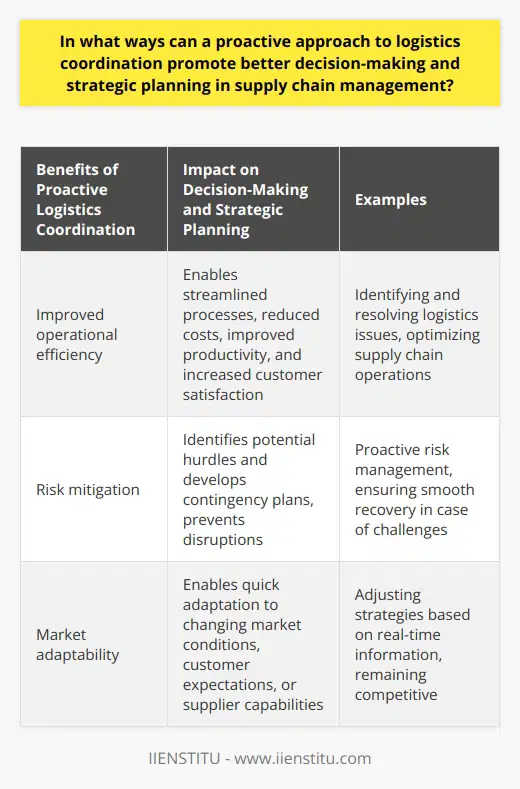
The Role of Coordination in Ensuring Smooth Logistics
Strategies for Coordinating Logistics
The Future of Logistics Coordination
Logistics is an essential component of any business model. It involves the movement and storage of raw materials, final products, and services and the organization of transportation, inventory, and supply chains. The purpose of logistics is to ensure that a company’s products and services reach customers on time and at the correct cost. To maximize efficiency, all aspects of logistics must work together seamlessly. This is where coordination becomes an integral factor.
The Role of Coordination in Ensuring Smooth Logistics
Coordination is ensuring that people, activities, and information are in sync. When it comes to logistics, coordination is critical to ensuring smooth operations. By collaborating with vendors, suppliers, and carriers, logistics teams can effectively communicate and manage the flow of raw materials, services, and products. This helps to streamline the supply chain, increasing efficiency and to reduce costs.
In addition to saving time and money, coordination facilitates problem-solving and issue resolution. By working together, logistics teams can quickly identify potential problems and issues with supply chains, vendors, or carriers and promptly address them before they become costly. In addition, coordination facilitates continuous professional development, as the logistics team and stakeholders can quickly share best practices and insights.
Strategies for Coordinating Logistics
When coordinating logistics, it’s essential to start by analyzing current strategies and processes. A thorough evaluation of existing operations allows logistics teams to identify any speed bumps or inefficiencies that could be improved upon. The development of a plan of action should then follow this. This should include a timeline, budget, and responsibilities of all involved stakeholders.
Automation can also be beneficial when it comes to coordinating logistics. By leveraging tools such as supply chain management software and mobile applications, companies can access real-time updates on their inventory levels and delivery times. Automation can also provide opportunities to save time and money and minimize human error.
The Future of Logistics Coordination
As technology advances, the coordination of logistics will only become more critical. New developments such as blockchain and artificial intelligence are expanding the potential of logistics teams, increasing the demand for experienced logisticians. Additionally, with the ever-increasing interconnectivity of global supply chains, companies must ensure that their operations run smoothly.
In conclusion, coordination is essential in the smooth running of logistics operations. Logistics teams can effectively manage the flow of goods and services by fostering communication, streamlining processes, and leveraging automation and technology. By doing so, they can ensure that products and services reach customers on time, reducing costs and increasing efficiency. Coordinating logistics is a valuable investment, leading to greater customer satisfaction and improved bottom lines.
The key to successful logistics lies in efficient coordination
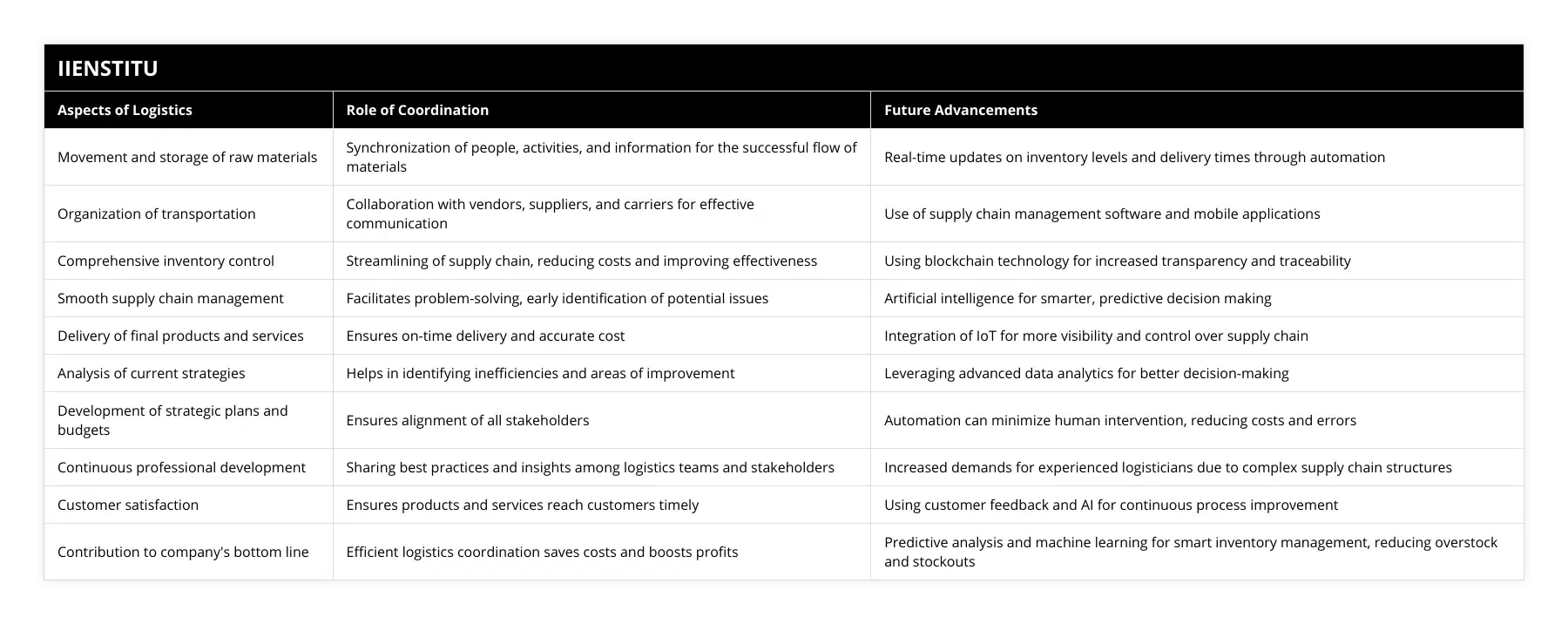
Frequently Asked Questions
How can supply chain coordination contribute to logistics efficiency?
Logistics efficiency is an essential success metric for businesses operating in the supply chain and transportation industry. In today’s world, where information technology has revolutionized how goods are produced and shipped, companies must work together to increase efficiency and remain competitive. Through effective coordination of efforts, supply chain coordination can offer a variety of advantages to improve logistics efficiency, ranging from better communication between different parts of the supply chain to an improved end-user experience for customers.
To begin with, one of the main ways supply chain coordination can contribute to logistics efficiency is by reducing the number of errors that occur in the supply chain. Errors can arise from various sources, such as inaccurate information, miscommunication, and misunderstandings. By coordinating with each other, companies can ensure that information is transmitted accurately and promptly. This helps reduce errors, eventually leading to fewer customer delays and delivery issues.
Additionally, supply chain coordination can improve customer service and an enhanced customer experience by shortening lead times and improving order accuracy. Companies can achieve this by coordinating activities across the entire supply network, such as using real-time algorithms to optimize inventory and route selection. This helps ensure that customers receive the products they ordered promptly and accurately, leading to increased customer satisfaction.
Finally, through vendor collaboration, supply chain coordination can help reduce costs and streamline trucking operations. Companies can utilize collaborative distribution networks to establish partnerships with carriers, allowing them to reduce their transportation costs and increase freight efficiency. This improved efficiency can reduce delivery times and decrease transport costs, allowing companies to pass on the savings to customers.
In conclusion, supply chain coordination is critical to achieving logistics efficiency. By coordinating activities across different parts of the supply chain, companies can reduce errors, shorten lead times, and improve order accuracy. Furthermore, supply chain coordination can decrease transport costs, allowing companies to pass on cost savings to customers. Effective coordination will enable businesses to increase efficiency, improve customer satisfaction, and gain a competitive edge.
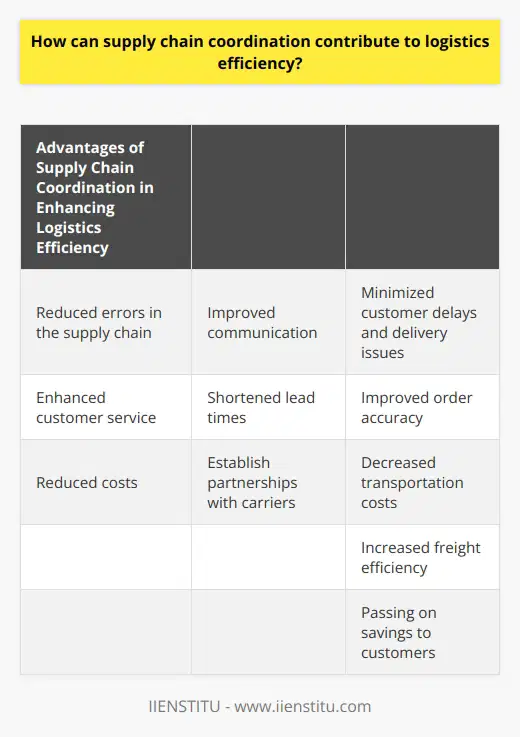
What strategies can be used to support effective collaboration between logistics partners?
Organizations increasingly recognize how essential collaboration is to manage supply chain operations successfully. Practical cooperation between logistics partners helps organizations create new strategies, realize cost savings, reduce supply chain risks, and gain a competitive advantage in the marketplace.
Organizational leaders can develop several strategies to support effective collaboration between logistics partners. First, a well-defined governance structure helps organizations clearly define the partners’ roles, responsibilities, and expectations. This clarifies accountabilities within the collaboration and allows for more informed decisions.
Second, organizations can promote information-sharing by establishing a shared database system where all partners can access the same data. With this system, partners become interoperable and able to exchange information synchronously. Third, organizations should develop a cooperation policy to establish clear rules related to the usage and preferred methods of data exchange. This helps increase standardization and reduce inefficiencies caused by inconsistency variations.
In addition, organizations should invest in effective communication channels that allow for rapid replies to inquiries and real-time order status updates. Furthermore, organizations should promote a culture of collaboration, which encourages co-creation and joint problem-solving. This helps build trust between the partners and allows them to remain engaged despite ups and downs. Finally, rewards and incentives can motivate partners to perform at their best and strengthen collaboration.
In today’s competitive business environment, organizations must leverage the power of collaboration with their logistics partners to drive value and gain a competitive advantage. Organizations that apply these strategies to support the cooperation between logistics partners can realize significant cost savings, create new designs and reduce risks through shared accountability and better data exchange. As such, a collaboration between logistics partners can be crucial for the success of any organization.
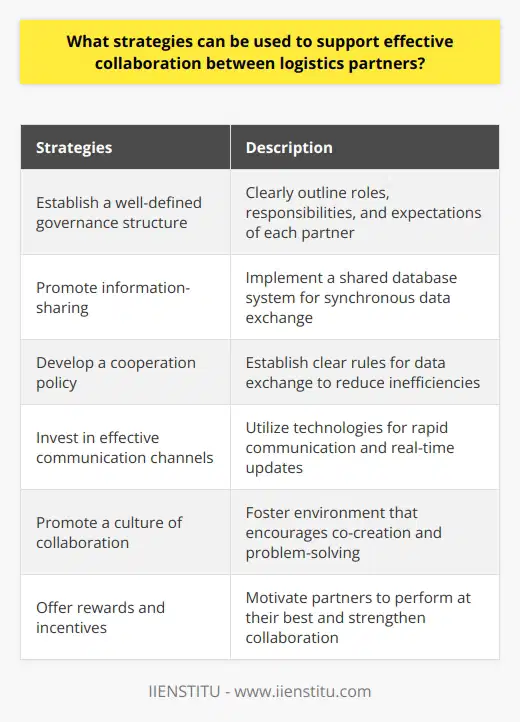
How can technology be used to facilitate smoother logistics operations?
Technology has become an integral part of modern life for businesses and individuals. Logistics operations have benefited immensely from technological advances over the past decade as companies can now automate and improve their operations. This article will discuss how technology can facilitate smoother logistics operations.
Automated tracking systems are one of the most critical technologies in logistics operations. Mechanical tracking systems allow businesses to keep track of their shipments in real time. This helps companies ensure that their goods arrive at their intended destinations on time and without problems. Automating the tracking process has also improved efficiency and accuracy as businesses can now easily and quickly access information related to the location of their shipments.
Another meaningful way that technology can be used to facilitate smoother logistics operations is through the use of automated warehouse systems. These systems allow for the efficient and accurate storage and retrieval of goods in a warehouse. In addition, mechanical warehouse systems reduce the time and energy required to complete long and tedious tasks such as packing and unpacking, organization, and inventory management.
Technology can also be used to improve the security of logistics operations. For example, GPS tracking devices can monitor shipments, helping businesses prevent theft and identify any delivery issues. In addition, advanced security protocols such as encryption and biometric authentication systems can help protect data from unauthorized access and misuse.
The use of technology has revolutionized how logistics operations are managed and automated. By automating tracking systems and warehouse operations and implementing advanced security protocols, businesses can improve their logistics operations and ensure that shipments reach their intended destinations on time and without any issues. Technology can thus play an essential role in ensuring that logistics operations run more smoothly daily.
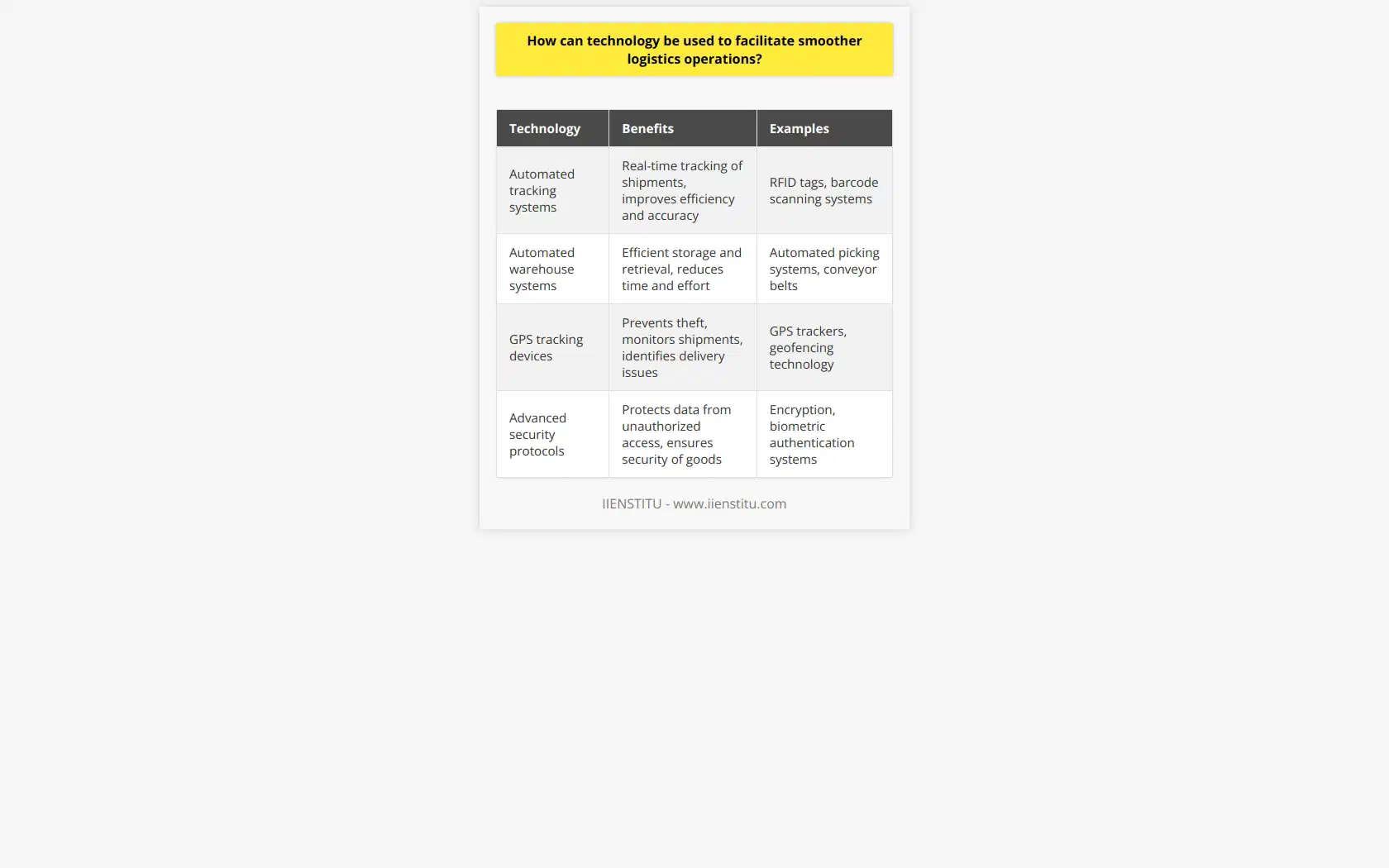
What is meant by coordination in supply chain management?
Coordination in Supply Chain Management
Defining Coordination
Coordination in supply chain management refers to the process in which different organizations or entities collaborate and synchronize key functions, activities, and information to ensure seamless operational efficiency. This process enables them to work efficiently and effectively to achieve common goals, such as reducing lead times, minimizing costs, and improving customer satisfaction.
Necessity for Coordination
Supply chains typically consist of numerous interconnected players, such as suppliers, manufacturers, distributors, retailers, and customers. As a result, there is a high degree of interdependence between the various entities. Therefore, effective coordination among the participants is crucial to achieve a well-functioning supply chain.
Key Coordination Mechanisms
Successful coordination in supply chain management entails the strategic use of various mechanisms to facilitate communication, information sharing, and synchronization of activities. Some of the key coordination mechanisms include:
Collaborative Planning, Forecasting, and Replenishment (CPFR): This technique involves working together with supply chain partners to achieve a unified forecast, which guides decision-making about production, inventory, and transportation activities.
Vendor-Managed Inventory (VMI): In VMI, the supplier assumes responsibility for managing and replenishing inventory at a predetermined location, such as a retailer's store or a distributor's warehouse. This mechanism enhances inventory visibility, improves order accuracy, and reduces stockouts.
Electronic Data Interchange (EDI): EDI is a digital communication standard that enables partners in a supply chain to exchange key business data, such as purchase orders, invoices, and shipment notifications, electronically. This ensures timely and accurate information sharing between organizations.
Barriers to Effective Coordination
Despite its importance, achieving coordination in supply chain management can be challenging due to various factors. Some common barriers include:
Information Asymmetry: A lack of transparency and consistency in information sharing among supply chain partners can lead to inefficiency and poor decision-making.
Organizational Silos: Misaligned goals, policies, and practices between different divisions within an organization can hinder cooperation and collaboration.
Distrust and Reluctance to Share Information: Some organizations may not be willing to share proprietary or sensitive information with other entities in the supply chain due to concerns about data privacy and competitive advantage.
In conclusion, coordination in supply chain management is essential for operational efficiency and competitive advantage. Employing effective coordination mechanisms, addressing barriers, and fostering collaboration among supply chain partners can contribute to a well-coordinated and successful supply chain.
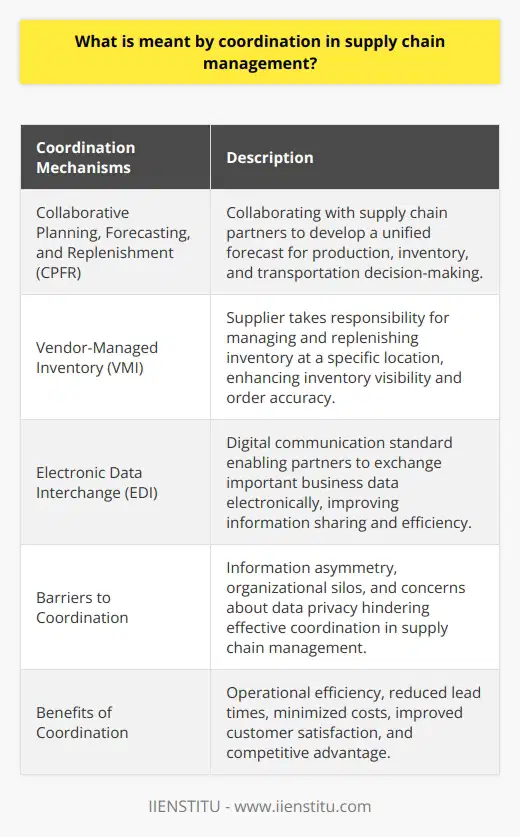
How do you ensure effective supply chain coordination for optimal performance?
Establishing a Collaborative Environment
To ensure effective supply chain coordination for optimal performance, it is essential to establish a collaborative environment between all stakeholders involved. This involves fostering open communication, trust, and mutual understanding among suppliers, manufacturers, and customers.
Leveraging Information Technology
Employing advanced information technology systems can facilitate seamless communication and quality data sharing in real-time. This aids in demand forecasting, inventory management, and overall coordination, ultimately reducing costs and ensuring timely delivery of products.
Developing Performance Metrics
Setting up relevant performance metrics helps organizations monitor and evaluate supply chain coordination efforts. Tracking KPIs such as lead times, on-time deliveries, and inventory levels will enable prompt course corrections and continuous improvements.
Fostering Long-Term Partnerships
Building long-term partnerships with suppliers and customers is crucial for supply chain coordination. Stable relationships promote the mutual exchange of information, shared risks, and joint problem-solving, leading to better collaboration and enhanced performance.
Implementing Cross-Functional Teams
Creating cross-functional teams comprising members from various functional departments can maximize the supply chain coordination process. These teams provide a holistic perspective on operations, facilitating the identification of bottlenecks, streamlining processes, and enabling better decision-making.
Incorporating Agility and Flexibility
Maintaining a resilient supply chain requires agility and flexibility to address unforeseen disruptions such as changing market demands or supplier disruptions. Organizations must adapt their strategies and operations quickly and efficiently to mitigate such challenges effectively.
Continuous Learning and Improvement
Organizations should promote a culture of continuous learning and improvement, with a keen focus on identifying areas of inefficiency and implementing corrective measures. This approach fosters innovation, adaptability, and a drive to enhance supply chain coordination performance.
In conclusion, ensuring effective supply chain coordination for optimal performance entails fostering collaboration, leveraging technology, establishing long-term partnerships, and incorporating agility in operational activities. By adopting these measures, organizations can achieve a coordinated supply chain that delivers higher efficiency, reduced costs, and improved overall performance.
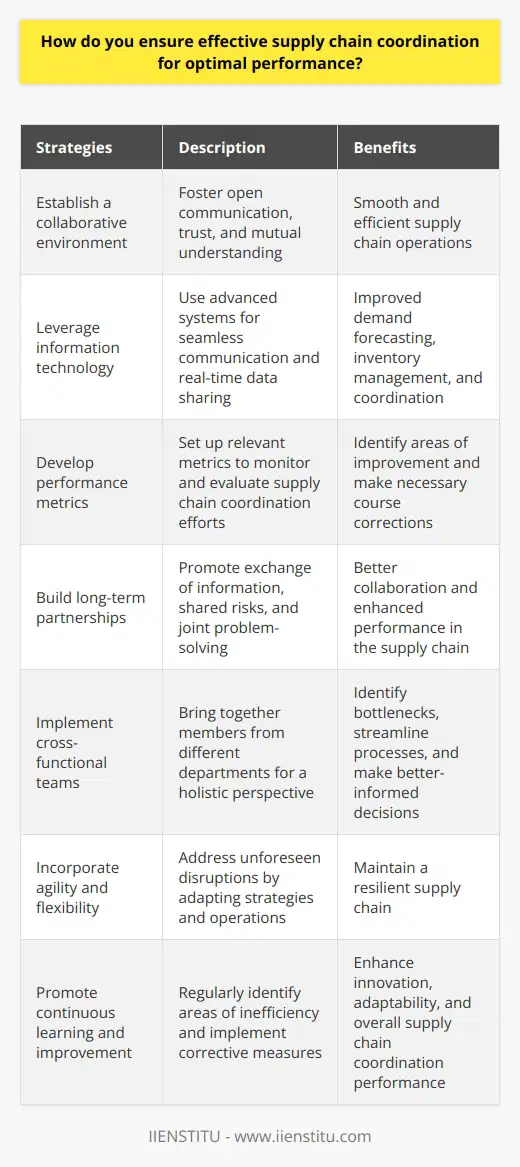
What is the best way to manage logistics in a complex and globalized supply chain?
Optimizing Logistics Management
One effective way to manage logistics in a complex and globalized supply chain is by implementing a centralized, data-driven approach. Centralized management of logistical processes enables supply chain managers to monitor the flow of goods from production to consumers, ensuring timely delivery and optimal use of resources. Moreover, data-driven decision-making allows for real-time adaption to fluctuations in demand and other unforeseen challenges in the supply chain.
Leveraging Advanced Technology
The integration of advanced technology plays a crucial role in streamlining global supply chains. Incorporating technologies such as artificial intelligence, machine learning, and the Internet of Things (IoT) into supply chain management enables real-time tracking, analytics, and decision-making at various stages of the supply chain. These tools help companies identify bottlenecks, minimize costs, and improve overall efficiency.
Building Collaborative Partnerships
Collaboration among stakeholders is essential in ensuring a seamless supply chain. This involves fostering strong relationships with suppliers, distributors, and logistics service providers. By leveraging their combined expertise, businesses can improve supply chain performance and mitigate potential risks. Additionally, collaborative partnerships encourage effective communication, which is paramount in managing a complex supply chain.
Embracing Sustainability
Sustainable practices are integral to successful supply chain management in the current global context. This involves prioritizing environmental, social, and economic goals to ensure long-term viability. Companies that adopt sustainable practices can reduce waste, minimize their carbon footprint, and improve overall efficiency. Furthermore, such practices can also enhance a brand's reputation and contribute to a more stable and predictable supply chain.
Continuous Improvement through Analytics
It is essential to monitor and measure supply chain performance regularly. Utilizing advanced data analytics tools, companies can gather and interpret data to make informed, data-driven decisions. Metrics such as lead time, delivery reliability, and inventory turnover can be analyzed to improve efficiency and responsiveness. This continuous improvement process enables businesses to identify areas of improvement and formulate appropriate strategies for optimizing supply chain performance.
In conclusion, managing logistics in a complex and globalized supply chain requires a centralized data-driven approach that leverages advanced technology and collaborative partnerships. Emphasizing sustainability and continuous improvement through analytics can further enhance the performance of global supply chains.
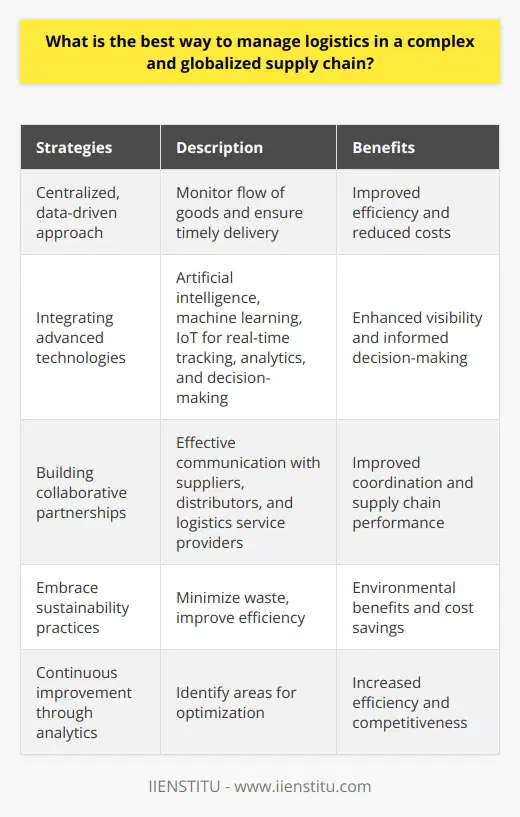
How do you ensure supply chain coordination in a globalized environment with multiple stakeholders?
Effective Communication and Information Sharing
Ensuring supply chain coordination in a globalized environment with multiple stakeholders necessitates effective communication and information sharing. Constant dialogue between all parties creates a collaborative atmosphere, facilitating quick problem-solving and fostering trust. Implementing communication platforms such as Enterprise Resource Planning (ERP) systems allows easy access to relevant data, ensuring transparency and efficient exchange of information.
Joint Decision-Making and Collaborative Planning
To enhance coordination, stakeholders should engage in joint decision-making processes and collaborative planning. This approach enables all parties to work together towards mutual objectives, aligning the supply chain towards common goals. Strategies like Vendor Managed Inventory (VMI) and Collaborative Planning, Forecasting, and Replenishment (CPFR) can effectively bring stakeholders together, streamlining processes and improving overall performance.
Strategic Partnerships and Long-Term Relationships
Developing strategic partnerships with key stakeholders promotes effective supply chain coordination. Establishing long-term relationships with suppliers, distributors, and customers aids in understanding each stakeholder's requirements and expectations. Such partnerships deepen trust and commitment between parties, enabling joint problem-solving while reducing the likelihood of opportunistic behavior.
Performance Monitoring and Continuous Improvement
Regularly monitoring supply chain performance is crucial in coordinating various activities. Key Performance Indicators (KPIs) should be established to measure and evaluate the efficiency and effectiveness of each stakeholder's role. Additionally, conducting periodic audits and assessments of the supply chain helps identify areas for improvement, ensuring continuous advancement and optimization of the process.
Investment in Technology and Infrastructure
Leveraging technology and infrastructure is essential in pursuing effective supply chain coordination. Modern solutions, such as the Internet of Things (IoT) and Artificial Intelligence (AI), can significantly improve supply chains' responsiveness and agility. Furthermore, the integration of automation and advanced analytics enables data-driven insights, helping stakeholders anticipate disruptions and plan accordingly.
In conclusion, ensuring supply chain coordination in a globalized environment with multiple stakeholders requires effective communication, joint decision-making, strategic relationships, performance monitoring, and investment in advanced technology and infrastructure. These approaches foster collaboration among stakeholders, enhance trust, and propel overall supply chain performance.
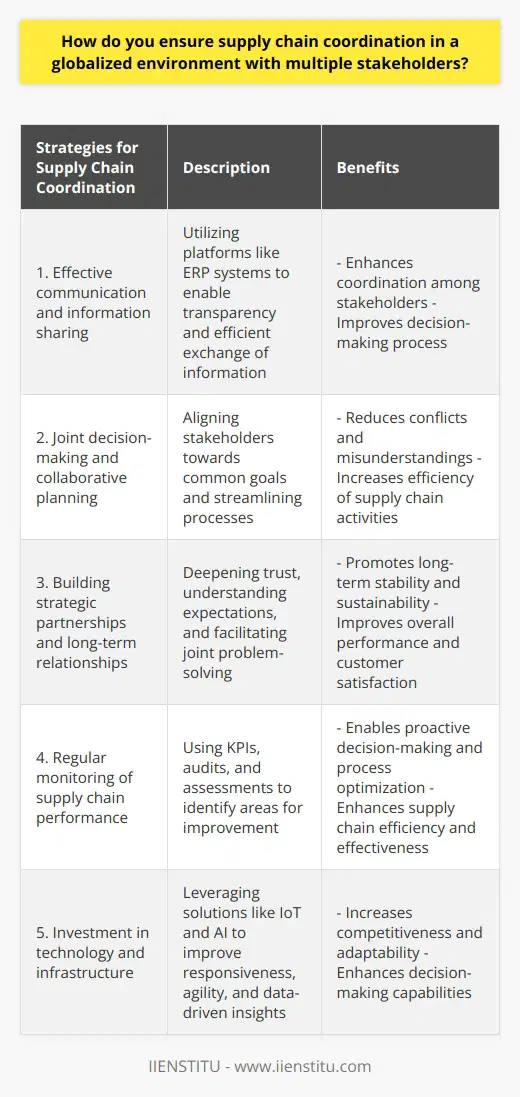
What factors contribute to effective coordination within a supply chain, and how can these factors be applied within different industry contexts?
Effective Communication
Among the various factors contributing to effective coordination within a supply chain, effective communication holds a prominent position. Communicating clearly and promptly can prevent misunderstandings and ensure that all stakeholders have the accurate and updated information necessary for making informed decisions. These communication practices can be applied across industries, including manufacturing, retail, and logistics, where multiple participants work together to deliver goods and services.
Technological Integration
Another significant factor in facilitating coordination within a supply chain is the integration of technology. Technology solutions like Enterprise Resource Planning (ERP) systems, inventory management tools, and data analytics software can help organizations streamline their processes, forecast demand accurately, and make data-driven decisions. This technological integration can be applied to various industry contexts, such as automotive, food and beverages, and pharmaceuticals, to enhance their operational efficiency and respond quickly to evolving customer demands.
Relationship Building and Trust
Strong relationships and trust among supply chain partners play a crucial role in ensuring smooth coordination. By establishing long-term partnerships with suppliers, manufacturers, and distributors, organizations can achieve better visibility, responsiveness, and flexibility in their supply chain operations. Moreover, cultivating trust by sharing information and collaborating on problem-solving fosters a sense of mutual accountability and commitment to achieving shared goals. This principle can be applied in various industries where multiple organizations work together, such as electronics, textiles, and consumer goods.
Cross-Functional Collaboration
Effective coordination within a supply chain also requires cross-functional collaboration. By breaking down silos and promoting a culture of cooperation among different departments, organizations can align their goals and strategies more efficiently. This collaboration enables the exchange of expertise, knowledge, and resources, leading to more informed decision-making and better responsiveness to market changes. Industries like aerospace, construction, and healthcare, which rely on the synergy of various teams and disciplines, can greatly benefit from employing cross-functional collaboration within their supply chain operations.
Continuous Improvement
Lastly, continuous improvement is an essential factor contributing to effective supply chain coordination. By regularly reviewing and analyzing processes, organizations can identify bottlenecks, inefficiencies, and areas for improvement. By addressing these issues and adopting best practices, organizations can enhance the overall performance of their supply chains. This iterative approach can be applied across various industries, including agriculture, energy, and information technology, where the constant evolution of processes and technologies demands incremental improvements in supply chain management.
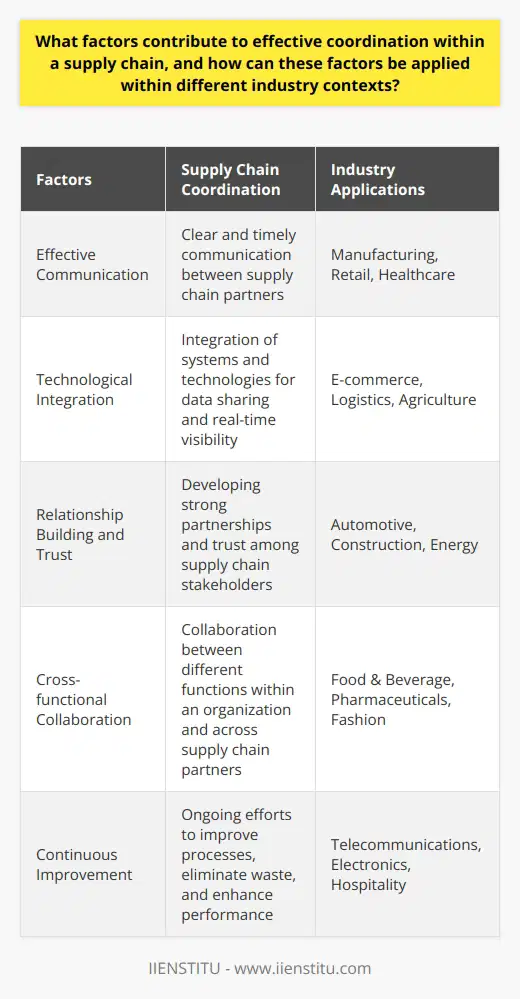
What are the key challenges faced when managing logistics in a modern supply chain, and how can organizations overcome these obstacles for improved coordination and performance?
Challenges in Modern Supply Chain Logistics
One key challenge faced in modern supply chain logistics is the increasing complexity of managing global networks. Organizations must deal with multiple suppliers, customers, and transport providers across various geographic locations, which can lead to communication difficulties, inaccurate demand forecasts, and risks such as political instability and natural disasters. To overcome these challenges, companies may employ advanced planning software, establish strong supplier relationships, and adopt risk management strategies, such as diversification and early-warning systems, to mitigate potential disruptions.
Technological Integration and Data Management
Another significant challenge is the integration of multiple information and communication technologies (ICT) within the management of the supply chain, resulting in the need for a unified data management approach. Streamlining communication and ensuring accurate data collection and sharing among supply chain partners is essential for improved coordination and performance. Organizations can leverage technology solutions, such as Enterprise Resource Planning (ERP) systems and Internet of Things (IoT) devices, to collect, process, and analyze data, providing accurate and real-time information that enables better decision-making.
Sustainability and Environmental Concerns
Growing concerns about environmental sustainability and social responsibility represent another vital challenge that supply chain logistics managers must address. The carbon footprint associated with transportation, manufacturing, and packaging processes is attracting scrutiny from both regulators and customers. To overcome this obstacle, companies can adopt environmentally friendly practices, such as optimizing transportation routes, reducing packaging materials, and investing in renewable energy sources. Additionally, businesses can enhance their corporate social responsibility (CSR) efforts by selecting suppliers with strong ethical and sustainability standards and ensuring fair labor practices throughout their supply chains.
Adapting to Changing Customer Demands
Finally, modern supply chain logistics face the challenge of adapting to rapidly changing customer demands and expectations. In an increasingly competitive market, businesses must respond quickly to new trends and varying consumer preferences. Organizations can overcome this challenge through the implementation of agile supply chain strategies, allowing them to rapidly adjust production levels, reconfigure manufacturing facilities, and shift to alternative suppliers when required. Ultimately, the ability to adapt and evolve in response to market pressures will prove crucial for supply chain success in a modern business environment.
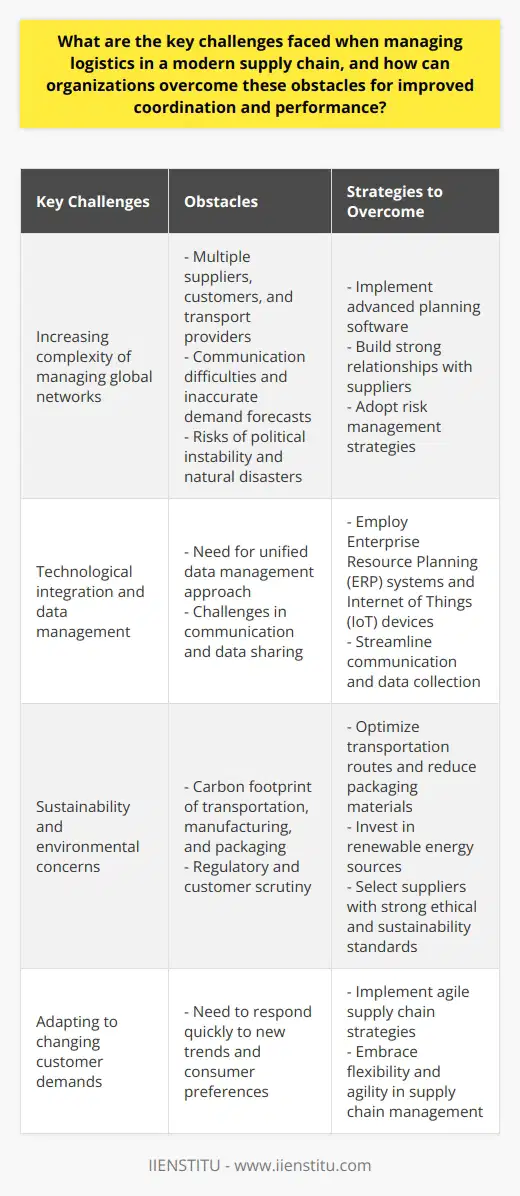
What is the role of communication in ensuring effective coordination in logistics?
Role of Communication in Coordination
Effective communication plays a crucial role in ensuring successful coordination in logistics. Clear and concise exchanges of information among various logistics partners are vital in maintaining proper functioning across the supply chain. This encompasses communication between suppliers, transportation providers, warehousing facilities, and end customers.
Information Sharing and Accuracy
One critical aspect of communication in logistics is the sharing of accurate and relevant information. Timely dissemination of data such as order statuses, inventory levels, and shipment tracking ensures all stakeholders have a comprehensive understanding of their roles and responsibilities. This transparency helps in avoiding misunderstandings that could lead to wasted resources, delays, or even significant financial losses.
Establishing Trust
Transparent communication contributes to the establishment of trust among logistics partners. Trust is an essential factor in maintaining long-term, mutually beneficial relationships among stakeholders. When all parties involved clearly understand the expectations and have assurance about the responsibilities being fulfilled, they are more likely to collaborate efficiently and effectively.
Decision-making and Problem Solving
Open and ongoing communication is also critical in fostering efficient decision-making and problem-solving within logistics. As unforeseen challenges and events arise, the ability to communicate rapidly and effectively is key to addressing and resolving issues promptly. When all the involved parties can quickly adapt and adjust their operations in response to changing circumstances, the entire logistics network benefits.
Technology Advancements
The implementation of advanced communication technology further enhances efficient coordination in logistics. Tools such as transportation management systems, real-time shipment tracking, and data analytics allow for quicker dissemination and better monitoring of important information across the supply chain. The integration of these systems can further streamline communication processes, resulting in improved efficiency, cost-savings, and ultimately, meeting customer expectations.
In conclusion, communication plays a vital role in coordinating logistics operations. By promoting the accurate exchange of information, fostering trust among partners, enabling quick decision-making and problem-solving, and leveraging the power of technology, effective communication contributes significantly to the overall success of any logistics network.
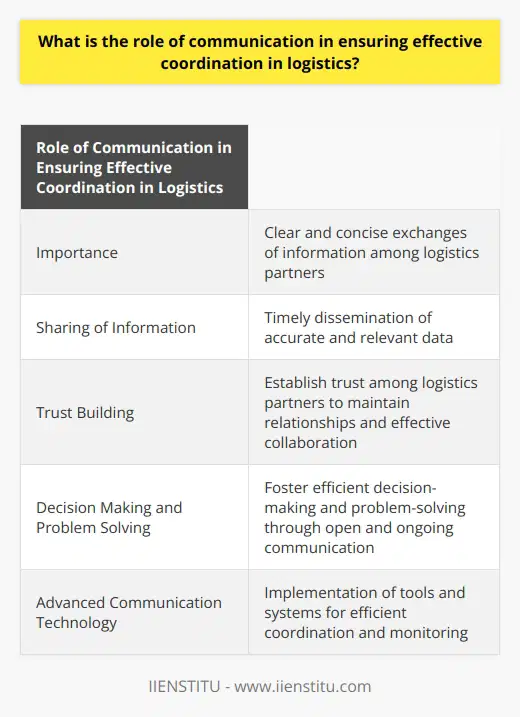
How can data analytics be utilized to optimize logistics management and supply chain coordination?
**Data Analytics in Logistics Management**
Data analytics can significantly enhance logistics management and supply chain coordination by enabling informed decision-making and improving operational efficiency. This is achieved through the systematic application of quantitative techniques and data-driven methods. The key areas where data analytics contribute to optimizing logistics management and supply chain coordination include demand forecasting, inventory management, and transportation optimization.
**Demand Forecasting with Predictive Analysis**
Predictive analytics enables businesses to forecast demand more accurately by analyzing historical data and identifying patterns. Accurate demand forecasting helps reduce stockouts and overstock situations, ensuring products are available to customers when needed. This not only enhances customer satisfaction but also minimizes inventory carrying costs and warehousing expenses.
**Inventory Management through Data-Driven Insights**
Effective inventory management is crucial for maintaining the proper balance between supply and demand. Data analytics provide insights into optimal stock levels by analyzing factors such as lead times, order quantities, and safety stock. Moreover, real-time tracking of inventory levels across the supply chain can prevent stockouts and improve order fulfillment rates. By leveraging analytics, companies can reduce excess inventory, minimize stock obsolescence, and optimize warehouse space usage.
**Transportation Optimization through Route Analysis**
Optimizing transportation is another critical aspect of logistics management where data analytics plays a vital role. By analyzing data on factors such as fuel consumption, travel time, and vehicle capacity, companies can identify the most cost-efficient routes and schedules for product deliveries. Additionally, real-time tracking of fleet movement and assessing external factors such as traffic conditions and weather changes can further optimize transportation logistics. This results in reduced transportation costs, faster deliveries, and lower carbon emissions.
**Conclusion**
Overall, data analytics enables businesses to achieve better supply chain coordination and logistics management by providing actionable insights derived from vast amounts of data. From predicting demand patterns, optimizing inventory levels, to identifying cost-efficient transportation routes, data analysis proves to be a powerful tool in enhancing operational efficiency and customer satisfaction. As the global market becomes increasingly competitive, businesses that successfully leverage data analytics in their logistics and supply chain operations will be well-positioned to gain a competitive edge.
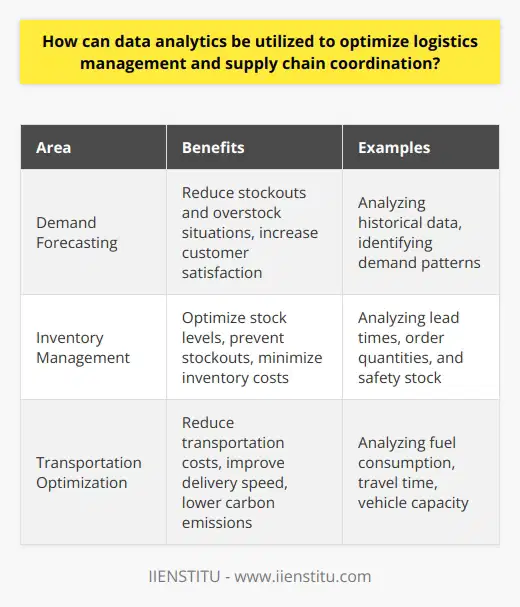
What principles and methodologies can be adopted to foster better collaboration and coordination across different stages of the logistics process?
Cross-functional Collaboration
One principle that can be applied to enhance coordination across various logistics stages is establishing cross-functional collaboration. This involves integrating departments, such as purchasing, production, and distribution, to create a seamless flow of information and resources. By promoting shared decision-making and problem-solving, cross-functional collaboration fosters better alignment of departmental objectives, enabling smoother logistics operations.
Agile Methodology
A commonly-employed methodology for promoting collaboration in logistics is the agile methodology. This iterative approach focuses on flexibility, adaptability, and responsiveness to changes in the market and customer demands. By fostering a culture of continuous improvement and open communication, agile methodology allows organizations to quickly adapt to new circumstances and deliver better results in the changing logistics landscape.
Centralized Information System
A crucial element in ensuring seamless coordination across the logistics process is a centralized information system. This involves the utilization of integrated software technology that provides real-time data and insights to all stakeholders involved in the logistics cycle. A centralized information system ensures accurate and timely decision-making, as well as improved tracking and visibility of the entire supply chain.
Standardized Processes and Procedures
Adopting standardized processes and procedures can also contribute to better collaboration across logistics stages. Standardization eliminates ambiguities and variations in operational practices, leading to improved consistency and efficiency. By providing clear guidelines, standardized processes facilitate better understanding and collaboration among team members, ultimately improving the overall logistics process.
Training and Skill Development
Lastly, continuous training and skill development are vital for enhancing coordination in the logistics process. By investing in employee development and nurturing a culture of learning, organizations can equip their personnel with the necessary skills and tools to perform their tasks effectively. A well-trained workforce is essential for promoting teamwork and collaboration and ensuring a smooth logistics process.
In conclusion, various principles and methodologies can be adopted to facilitate better collaboration and coordination across different stages of the logistics process. These include cross-functional collaboration, agile methodology, centralized information systems, standardized processes, and continuous training and skill development. Implementing these strategies can significantly improve the efficiency and effectiveness of logistics operations, allowing organizations to remain competitive and responsive in today's dynamic and evolving marketplace.
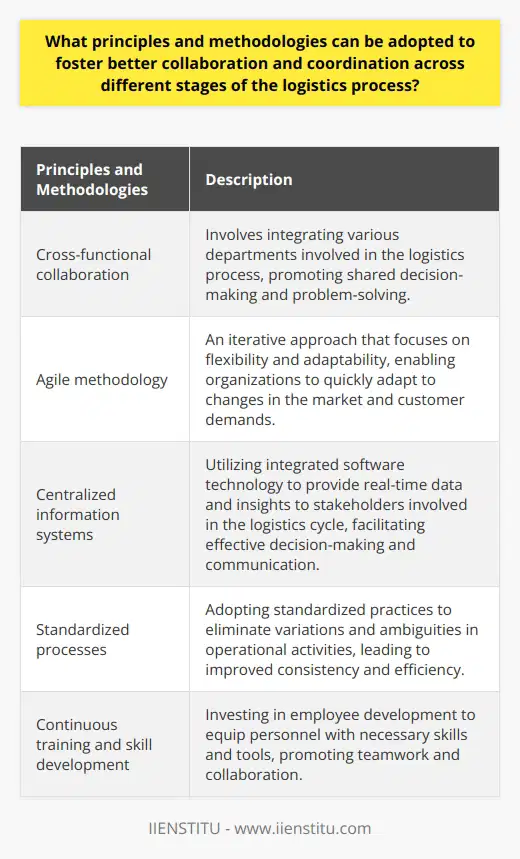
What is the relationship between supply chain coordination and the overall effectiveness of logistics management?
Role of Supply Chain Coordination
Supply chain coordination forms an integral aspect of effective logistics management. It aligns all supply chain activities towards fulfilling customer needs. Coordination ensures the right goods reach the right location at the right time. It mitigates supply chain risks and minimizes delays, promoting efficiency.
Impact on Logistics Management
Coordination's effects on logistics management are multifold. First, it streamlines operations. Optimal resource utilization results from accurate information flow and decision-making. Second, supply chain coordination helps identify bottlenecks and gaps within the system. Remedial actions can then promptly address these issues.
Efficiency through Coordination
Moreover, achieving overall efficiency in logistics management largely hinges on robust supply chain coordination. Efficient coordination ensures seamless integration of various supply chain elements. These may span from procurement and production to distribution and customer service. By synchronizing these aspects, businesses can often boost their operational efficiency and overall effectiveness.
Inventory Management
Besides coordination boosts inventory management, a critical aspect of logistics management. It allows timely replenishment of stock, avoiding unnecessary stockouts or overstocks. Effective coordination can also forecast demand more accurately, leading to better stock allocation and reduction in holding costs.
In Conclusion
To sum up, supply chain coordination and the overall effectiveness of logistics management are intricately linked. Coordination drives efficiency, optimizes resources, and improves inventory management. Therefore, developing a resilient, agile, and flexible supply chain coordination mechanism can greatly enhance logistics management's effectiveness.
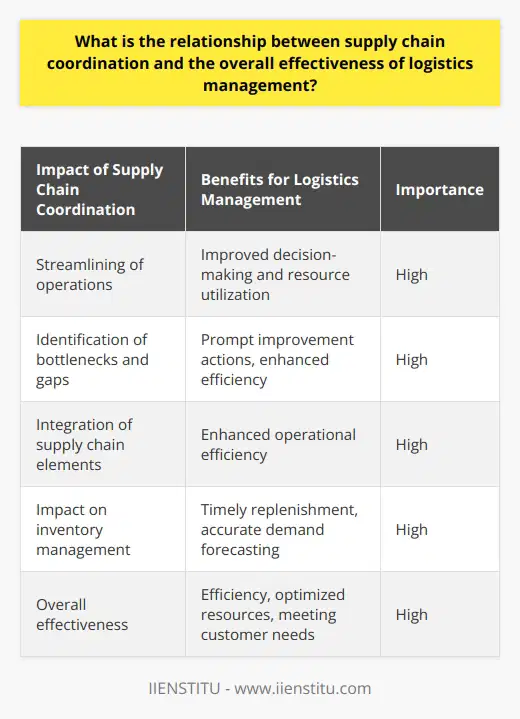
How can companies implement best practices for coordination to improve the efficiency and sustainability of their logistics operations?
Understanding Logistics Coordination
Companies need a thorough understanding of logistics coordination. This involves precise management of inventory, distribution and activities connecting manufacturers, suppliers and customers.
Utilize Collaborative Planning
Implementing Collaborative Planning, Forecasting and Replenishment (CPFR) methods is beneficial. This synchronizes demand forecasting and inventory replenishment between trading partners, leading to more efficient operations.
Adopting Digital Technology
Digital technology adoption can improve logistics coordination. Technology like Artificial Intelligence, Internet of Things, and blockchain provide real-time inventory tracking, route optimization and secure data exchange.
Integrate Supply Chain Management
Supply Chain Integration (SCI) is necessary for operational efficiency. Integrated supply chains with regular communication and transparency lead to smoother operations reducing chances of mistakes.
Implement Green Logistics
Adoption of green logistics can advance sustainability. Best practices include fuel-efficient transport, renewable energy and waste reduction. These not only lower costs but also decrease the environmental impact.
Promote Employee Training
Employee training promotes understanding of coordination processes. Well-trained staff can identify potential issues faster, make knowledgeable decisions and foster productivity.
Encourage Supplier Collaboration
Supplier collaboration is essential for efficient logistics operations. This strengthens relationships, mitigates risks, and improves overall efficiency.
Invest in Research and Development
Investment in Research and Development (R&D) propels innovative solutions for better coordination practices, leading to efficient and sustainable operations.
To conclude, logistics coordination involves a mix of best practices - technology, employee training, supplier collaboration, and green alternatives. Companies should continually improve their practices for a sustainable future.

In what ways can a proactive approach to logistics coordination promote better decision-making and strategic planning in supply chain management?
Proactive Approach to Logistics Coordination
Supply chain management can significantly benefit from proactive logistics coordination. One of the core ways is through improved decision-making. When logistics gets upfront visibility into potential disruptions or changes, stakeholders can make informed choices. They can better prepare and optimize their operational decisions while minimizing potential impacts of disruptions.
Strategic Planning Enhancement
Supply chain strategy also gets a boost from proactive logistics coordination. It provides insights into customer demand, market trends, and other factors that can influence strategic planning. This solid, real-time feed of information allows companies to anticipate changes and plan accordingly. It ensures that strategies align with the realities of the market.
Boost in Efficiency
Another benefit of proactive coordination is increased operational efficiency. By anticipating and resolving logistics issues in advance, companies can streamline their processes. This leads to reduced costs, improved productivity, and increased customer satisfaction. Overall, a proactive approach to logistics coordination acts as a critical tool for increasing efficiency in supply chain management.
Risk Mitigation
Proactively managing logistics also aids in mitigating risks. It enables companies to identify potential hurdles and develop contingency plans. This proactive risk management approach not only prevents disruptions but also ensures smooth recovery.
Market Adaptability
Finally, proactive logistics coordination promotes adaptability. It allows supply chains to respond quickly to changing market conditions, customer expectations, or supplier capabilities. This adaptability is vital in today's dynamic and competitive business environment.
In conclusion, a proactive approach to logistics coordination promotes better decision-making and strategic planning in supply chain management. It helps in improving operational efficiency, mitigating risks, and increasing market adaptability. Therefore, proactive logistics coordination is an essential strategic tool for companies aiming for supply chain excellence.
